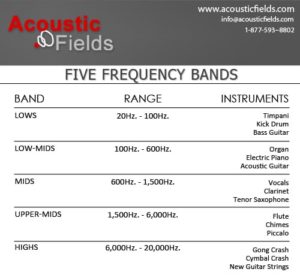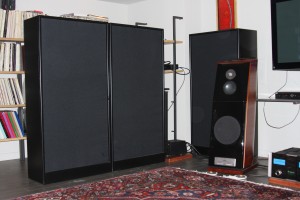Parts 1 – 3
In part one of this series, we discussed how important it was to choose the correct room size. In part two, we discussed speaker and listening position and its importance to room frequency response. Part three we discussed low, middle, and high frequency room treatment. In this part four, we will focus on low frequency resonances and the importance of low frequency management through appropriate absorption technologies.
Low Frequency Definition
There is so much misunderstanding when it comes to low frequency energy in small room environments. There is also a large misunderstanding of what constitutes low frequency. Low frequency is any frequency below 100 Hz. Human hearing is broken up into five critical bands in our audio world. Low frequency is any frequency below 100 Hz. Lets keep this round number of 100 cycles in mind as we proceed forward with our discussion.
Low Frequency Pressure Plots
Low frequency energy into our rooms does not fit because of its long wavelengths. Since it doesn’t fit, it builds up and creates pressure areas within the room. These pressure areas occur at room boundary intersection such as the intersection of floor to side walls and side walls to ceilings. The corners of our room are also areas of higher pressure for low frequencies. The corners of our room are also havens for other room modes that represent higher frequencies. We must pay attention to these low pressure areas if we are to have any chance of an equal representation of all frequencies at our listening position which is our goal.
Low Frequency Management
There are three main ways to manage low frequency energy within our rooms. First, we can choose a room size that can handle the pressure that long low frequency energy creates. This is the best option, although the one not usually chosen. It is better to choose a room that has the proper ratio of width, height, and length to be able to handle low frequencies. There are ratios that work well with lower frequencies. One can spend the money up front and choose a room that has the proper size and volume or one can add sound absorption technology to existing rooms and spend more money. It is a case of pay me now or pay me later.
Tuned Absorbers
Tuned absorbers called Helmholtz resonators are another option. These are technologies that are cabinets with certain depths or lengths and have a tuned port or slat that air enters through. The air vibrates inside the chamber and is reduced in intensity. They can be built into walls within the room or be freestanding units located in areas of highest pressure. A glass coke bottle is an example of a Helmholtz resonator, with a resonant frequency of around 185 Hz. Frequencies above 185 Hz. are absorbed. The resonant frequency of the unit defines the lowest limit of the unit’s absorption.
Diaphragmatic Absorbers
Diaphragmatic absorbers are another option that is used extensively in the professional market but not readily known in the consumer market even though the interior walls of their listening room are probably a diaphragmatic absorber. A diaphragmatic absorber is a cabinet with a certain depth and a certain density. Both depth and density are critical components. One needs cabinet depth to absorb lower frequencies along with the cabinet density. Foam, tubes, and boxes filled with building insulation will not absorb frequencies below 100 cycles. They will above 100 Hz., but not below.
Resonance Locations
Low frequency resonances must be defined and located within the room. Once defined and located, one can design the particular low frequency technology that will absorb at the necessary rate and level to minimize the amplitude of the resonances within our rooms. We may need to design absorbers that can handle low frequency issues that go from say 30 Hz. – 50 Hz. These frequency specific absorbers must be designed with care and attention to cabinet size, depth, and density. Broadband absorbers covering a wider frequency range can also be designed. One must define the low frequency issues and then design the proper type of absorber and place it in the correct location.
Low Frequency Management
Managing low frequency energy within our smaller rooms is always an exercise in compromise. Without the correct ratio of width, height, and length, we are always climbing up hill. We will never be able to achieve a perfect absorption curve, but we can minimize resonances so that they do not pervade our sound stage presentation all the time. We can forget about achieving a flat response down to 20 cycles and use 30 cycles as our low end goal. Thirty cycles represents the lowest string on a five string bass and will also cover any low frequencies generated by a bass drum.
No More Mud
Without proper low frequency energy management, our sound stage presentation will be plagued with low frequency mud. We have all heard this. It is the blurring and smearing of everything we value, especially in the mid range area where our emotional connection to the music lies. Resonances can be at 30 cycles and all of its fundamentals. A microphone placed in a room mode will not hear certain frequencies and may hear too much of others. Resonances and their reduction through proper low frequency management technologies should be the first goal of any listening room build.
How to build a listening room part one
How to build a listening room part two
How to build a listening room part three
So I hope that helps you. If you would like a free analysis of your current room plans, please complete the form on this page www.acousticfields.com/free-acoustic-treatment-room-analysis-tell-us-about-your-room/ and we will run a free analysis for you. If you have any questions at any time I am always on hand to help answer them. Leave them in the comments section or email me at info@acousticfields.com. If you would like to learn more about room acoustics please sign up for my free videos and ebook by joining the mailing list here. We send room tuning tips and things for you to test in your room every Wednesday. They are easy to follow and really help you enjoy more of your music.
Thanks
Muke








One Comment